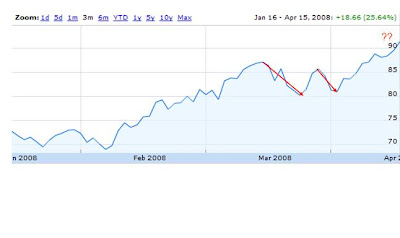Pretty much the same old stuff from this article about retiring rich--your expenses will stay about the same in retirement, inflation eats away at your money, Medicare doesn't cover all medical expenses, and so on. But read it anyway, mainly for the last sentence.
Retire Rich: Learn From Someone Who Did
by Walter Updegrave/Money Magazine
When Henry "Bud" Hebeler was winding down his career at Boeing nearly 20 years ago, he was appalled at the advice he got from retirement planning software.
"The assumptions about returns, inflation, longevity and expenses were highly simplistic," says the 74-year-old Hebeler. With his engineering degrees from MIT and his experience - first as Boeing's chief forecaster and planner and later as president of Boeing Aerospace - Hebeler figured he could do better.
He has. His Web site, AnalyzeNow.com, is a compendium of advice and tools (mostly free) that can help you tackle topics ranging from how to create a retirement budget to whether to buy an annuity.
What distinguishes Hebeler from the typical retirement "expert" is that he combines a strong quantitative background with real-life retirement experience - his own and that of fellow retirees.
Hebeler took time out from his hectic schedule of skiing, golf, travel and running a site to share his thoughts.
Q. What's the most popular misconception about retirement planning?
A. That your spending will drop as you age and you become less active. My father played golf until he was 95. My wife and I are in our seventies and we ski the expert slopes at Park City, Utah.
My friends who have reduced their spending didn't do so because of lack of energy or physical ability. It doesn't take much effort to get into a taxi and go to the theater. They're cutting back because they know they're going to live longer than they thought they would. They spent too much too early and now they're worried about running out.
Q. So what can you do to assure that your money will last?
A. If you have enough savings to live on, consider delaying taking Social Security until full retirement age or even later. Holding off can be especially worthwhile if you have a spouse who didn't work or had a low income, since the higher payment you get by waiting can be passed on to your spouse when you die.
I also think retirees should consider putting some, but not all, of their money in an immediate annuity. Look at inflation-adjusted immediate annuities, since they provide a lifetime income that, like Social Security, goes up with inflation.
Q. How did your work at Boeing influence the advice you give?
A. It made me more conservative. In business you see how often things don't work out as you planned. Projects cost more to complete than you estimated.
The same is true of retirement, but retirement plans seldom call for setting aside reserves for unforeseen events. There are a lot of surprises, usually more bad ones than good.
Q. What kinds of surprises?
A. For one thing, your expenses are likely to be very different in retirement than during your career. Things that were probably covered by your company insurance - dental work, vision care, a variety of medical tests - typically aren't paid for by Medicare. My hearing aids alone cost $6,000, which wasn't covered at all.
People also don't anticipate the impact of inflation. In the first 10 years of my retirement, the purchasing power of my company pension declined by 30%. And then there are obligations people rarely plan for, such as having to help parents or adult children who are struggling financially.
Q. If you could advise people to do just one thing to improve their retirement prospects, what would it be?
A. People who aren't retired need to know how much to save. My father used to tell me that you should always save at least 10% of your income.
That's more like 15% to 20% today because you're less likely to have a pension.




 Next, check out the 5 year view, as the Vice Fund completely trounces both benchmarks at 144% for Vice vs. less than 60% for the benchmarks:
Next, check out the 5 year view, as the Vice Fund completely trounces both benchmarks at 144% for Vice vs. less than 60% for the benchmarks:




